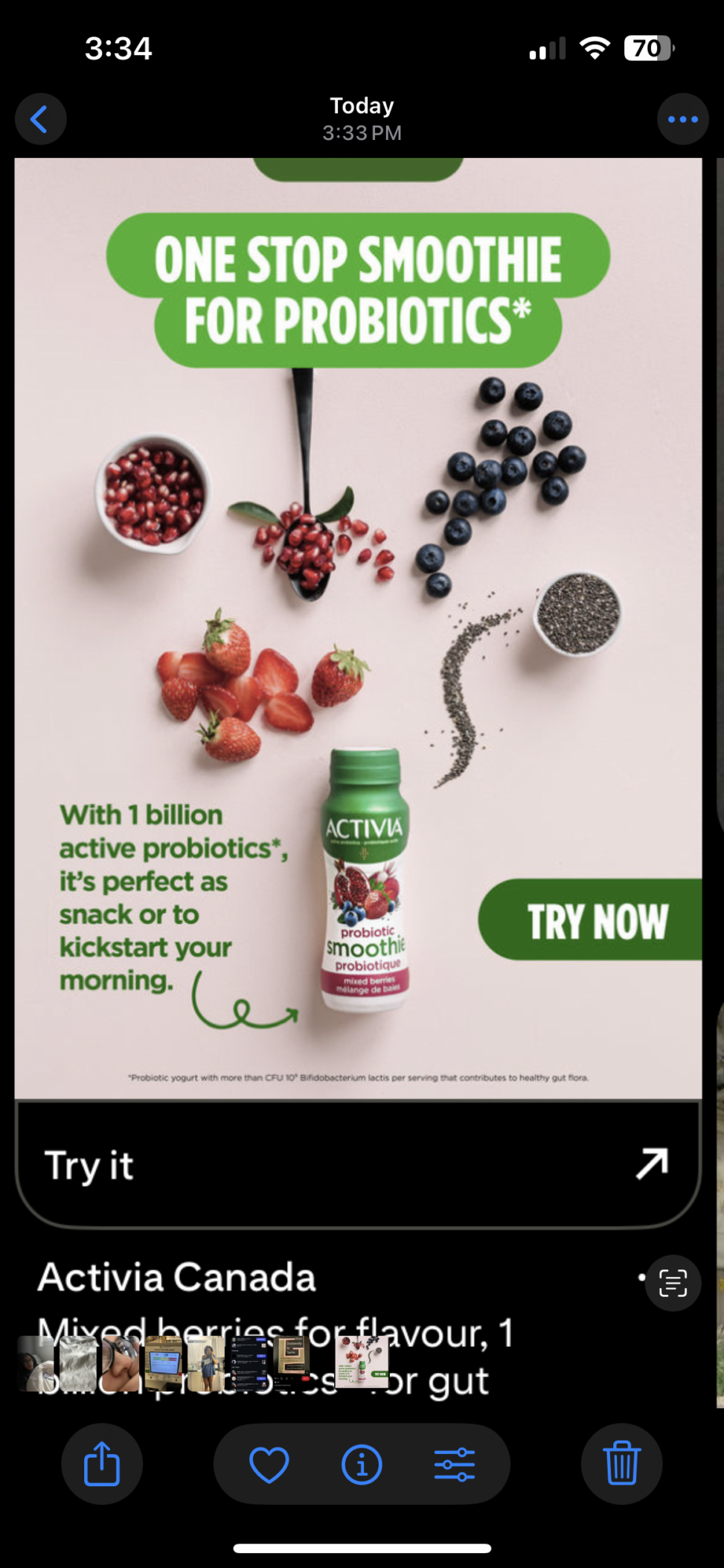This is an advertisement made by the brand Activia, a dairy-based health food company that sells products that promote the importance of gut health. This advertisement specifically promotes their probiotic beverage. The ad promotes the convenience, taste, and health benefits of the product in an easily digestible, image-based advertisement that is appealing to consumers.
The ad itself is simple, depicting a solid pastel pink background and the fruits included in the smoothie as well as the bottle itself. The ad’s composition is made up of small portions of pomegranate, blueberries, strawberries, and chia seeds—the most natural ingredients that happen to be the most recognizable for viewers. The fruits are sprawled out on the background in an aesthetically pleasing manner that makes the fruit look that much more appetizing. The ad includes minimal text, including a large header saying, “One-stop smoothie for probiotics.” This reinforces the product’s convenience and benefits. This is one of the main focal points of the image as well as the fruit display. Overall, the advertisement is successful in its appeal towards the product.
The message of the ad itself is simple: this probiotic beverage is an accessible, convenient way to support your gut health through healthy eating. This is reinforced through the placement of the main fruits the beverage contains as well as the small, compact bottle it comes in. All the fruits are sprawled out in intentional spirals towards the product itself, guiding the viewers’ eyes down to the bottle regardless of where they are looking. It claims to be socially responsible through its alleged use of mostly fruits and the products’ health benefits. I am familiar with the brand Activia, and most people who are familiar might find this advertisement appealing. Personally, I dislike the extreme increase in advertising in general and am less likely to find any ad appealing because of my strong dislike towards the idea.
Though the ad is successful in conveying their message of the importance of choosing their product as a gut-healthy addition, it lacks an explicit attempt to persuade through its imagery alone. If the text were removed, the idea of gut health would be less apparent, but the push to sell their product would continue to be evident. Viewing the advertisement through a critical lens, the obvious target audience is health-conscious adults looking to include more healthy options in their routine. I believe that this advertisement does a great job at displaying their message and intentions to the audience. The persuading elements of this advertisement are minimal, and the product itself does more of the work due to the brand’s popularity.
Danone, the parent company of Activia, has a less than pristine track record regarding their marketing strategies. In the 2000s the brand claimed that using its product daily could relieve bowel movement irregularities, stating that these claims were “scientifically proven.” In 2010 the U.S. Federal Trade Commission charged them with deceptive advertising due to these claims and forced them to rid their advertisements of these false claims. As well as false claims in the scholarly article “Toned tummies and bloated bellies: Activia Yogurt and Gendered Digestions,” author Emily Contois accuses the brand of gendered marketing. “The marketing of Activia yogurt reveals a modern adaptation of the historical abdominal woman, as the female target audience is quite literally reduced to a perfectly flat abdomen.” (Contois 2013) In her article she speaks on a specific advert displaying a woman’s midsection that reinforces the idea that their product will aid in achieving the slim figure desired by young women. The rhetoric of “gut health” in general is targeted at women because of the overwhelming female population that deals with irritable bowel syndrome (IBS). Even the bottle itself pushes the narrative of that desired hourglass figure because of its shape. The bottle is very slim and is shaped in that same hourglass. This subconsciously links the Activia probiotic drink with the most desired body shape among women.
According to the complaint file from the Federal Trade Commission (FTC), another exaggerated advertisement of a young boy looking pale and disoriented was deemed false advertising. The sick-looking boy drinks the Activia probiotic drink and instantly looks healthier. The FTC deemed the advertisement to be an exaggeration of the product’s effects and ordered that the brand remove it from circulation because of its validity. “IT IS FURTHER ORDERED that respondent, directly or through any corporation, partnership, subsidiary, division, trade name, or other device, in connection with the manufacturing, labelling, advertising, promotion, offering for sale, sale, or distribution of any covered product, in or affecting commerce, shall not make any representation, other than representations covered under Parts I through III of this order, in any manner, expressly or by implication, including through the use of a product name, endorsement, depiction, or illustration, about the health benefits, performance, or efficacy of any covered product, unless the representation is non-misleading, and, at the time of making such representation, respondent possesses and relies upon competent and reliable scientific evidence that is sufficient in quality and quantity based on standards generally accepted in the relevant scientific fields, when considered in light of the entire body of relevant and reliable scientific evidence, to substantiate that the representation is true” (Federal Trade Commission 2010) Excluding Activia, the parent company, Danone has many other claims of false advertising that will not be covered in this analysis. The company is not a reliable source of information in respect to health or scientific claims.
The knowledge that Activia has a history of gendered marketing and false advertising changes the way I and others may view their advertising moving forward. It’s a huge issue for a brand that claims to benefit your health to have a long record of over exaggerating their products’ effects because it removes the validity of all claims they attempt to make in the future. In general, the main advertisement analysed did a good job promoting their product using imagery and visual hints, but with the knowledge that they are known to spread a false narrative, it makes the brand and product less desirable. Overall, the average person may be interested in this beverage due to this simple advertisement, but those who are aware of their past infractions may be less likely to support and trust their brand.
—————————————————————————————————————-
Bibliography
Contois, written by E., Says, Says, E., Says, S., & Says, V. (2015, March 22). Toned Tummies & bloated bellies: Activia yogurt & gendered digestion. Emily Contois. https://emilycontois.com/2013/05/06/toned-tummies-bloated-bellies-activia-yogurt-gendered-digestion/
Federal Trade Commission v. Danone, No. 082 3158 (D.D.C. 2010). https://www.ftc.gov/sites/default/files/documents/cases/2011/02/110204dannondo.pdf


Fatima Keita
In the following analysis, the student gives a concise, well-structured explanation of the advertisement’s visual, composition, and message. They discuss the use of pastel colours, fruit arrangement, and minimal text to communicate ideas of health and convenience. Their writing is powerful in connecting the ad’s design elements, such as the bottle and the arrangement of fruits, to underlying marketing strategies targeting health-conscious consumers.
In terms of greenwashing critique, the student touches more on false health claims and gendered marketing than on environmental responsibility. While these points are valid and well supported with scholarly and regulatory evidence, the assignment also calls for attention to greenwashing, which the analysis does not explore in depth. For instance, the student could have examined whether Activia or Danone use environmental imagery, such as natural fruit layouts, to imply eco-friendliness or naturalness, despite the company’s large-scale dairy production and packaging waste.
Their use of real sources, such as Emily Contois’s article and the US Federal Trade Commission report, is impressive and adds credibility to their critique. Overall, this submission is persuasive and well-researched, but it would benefit from expanding the discussion of environmental greenwashing and the company’s broader sustainability practices.